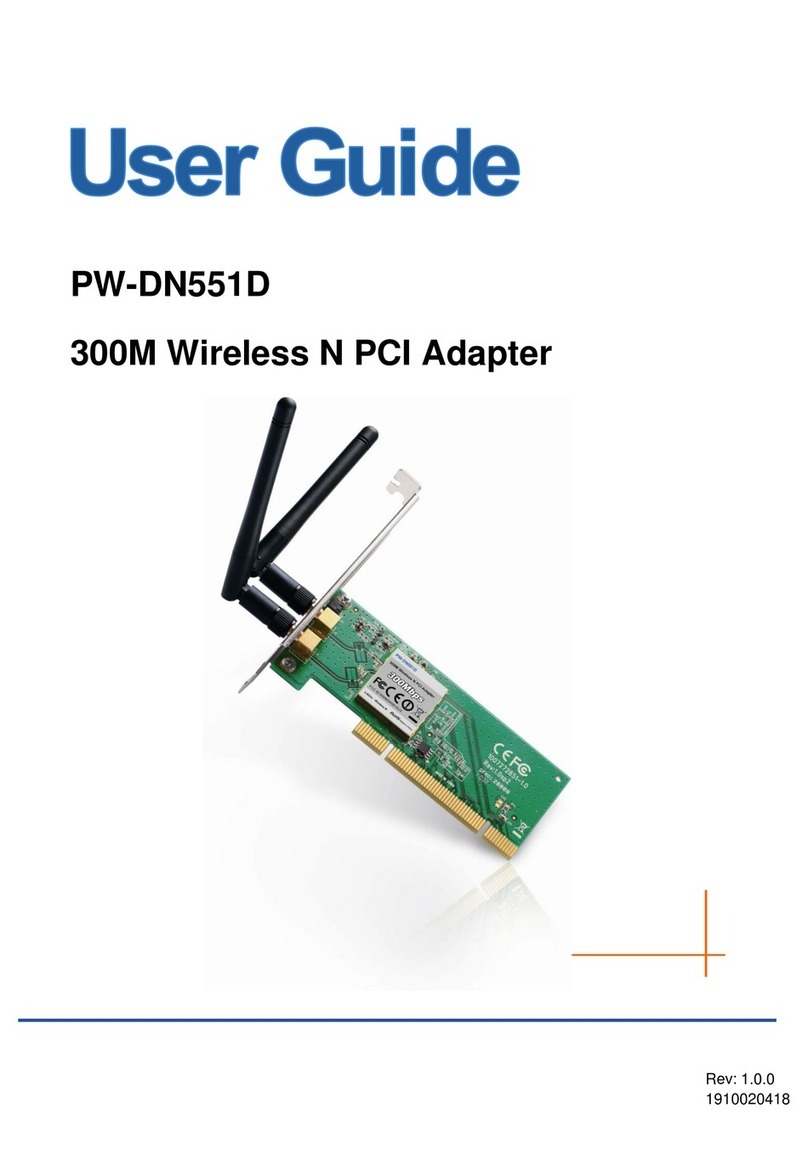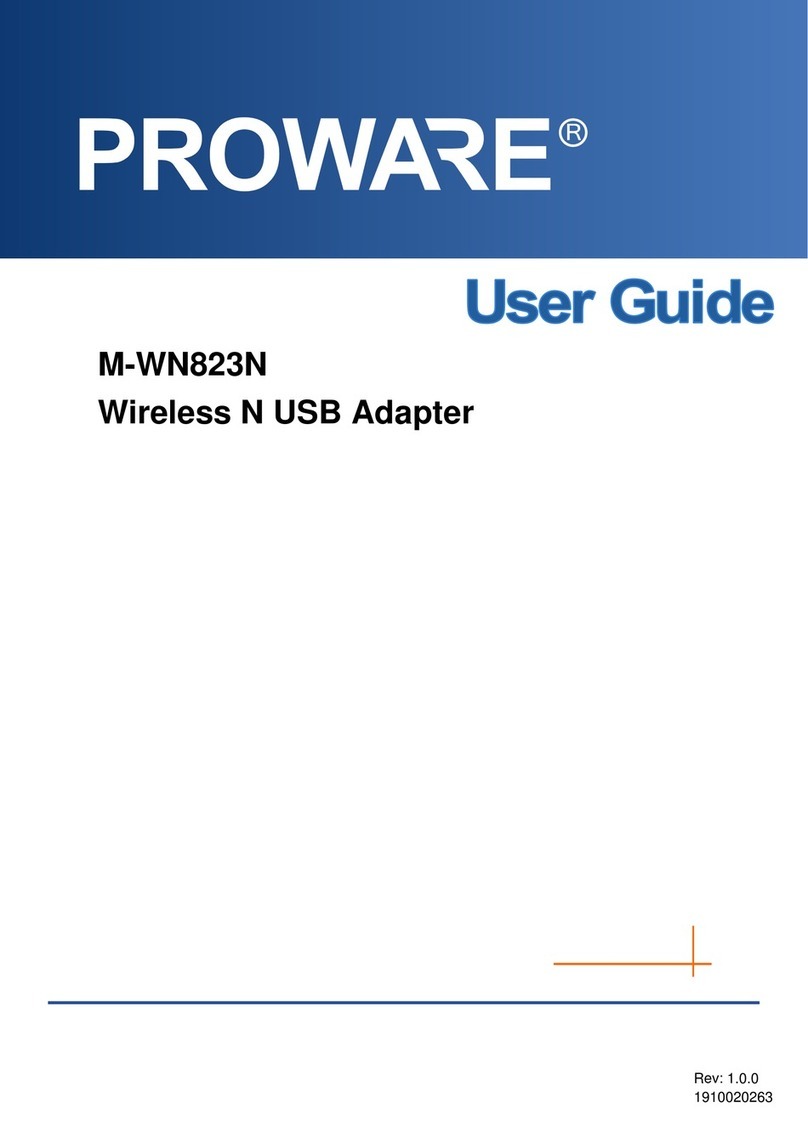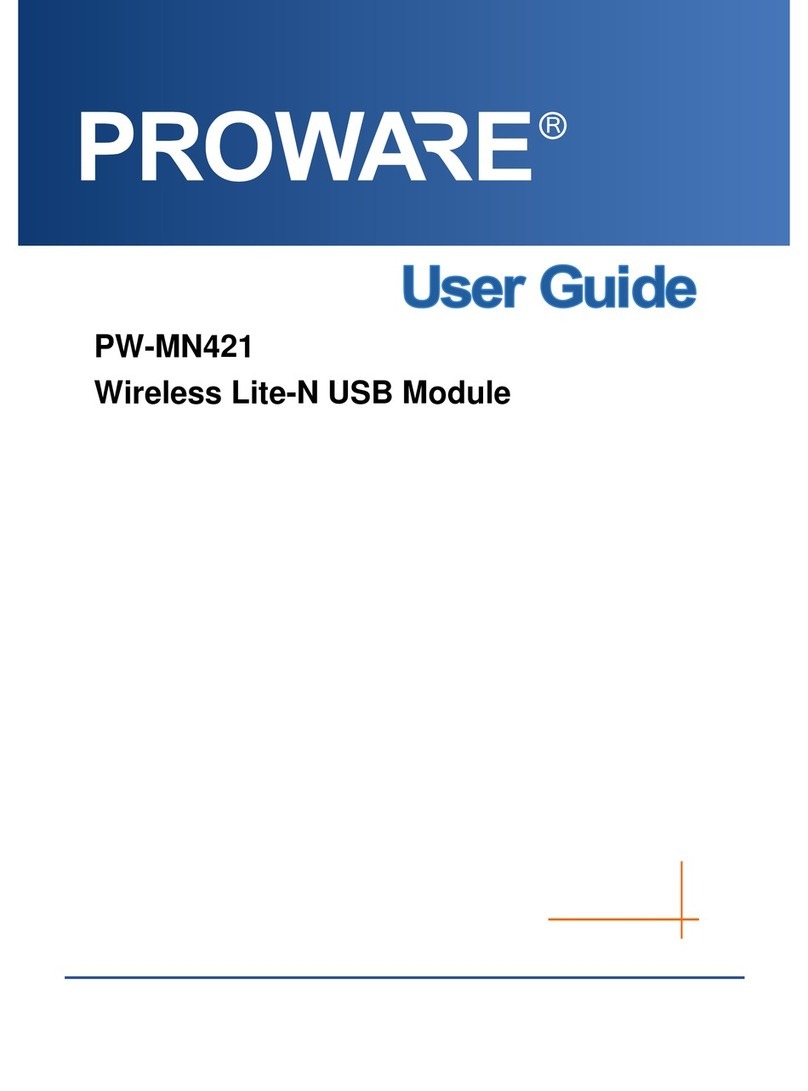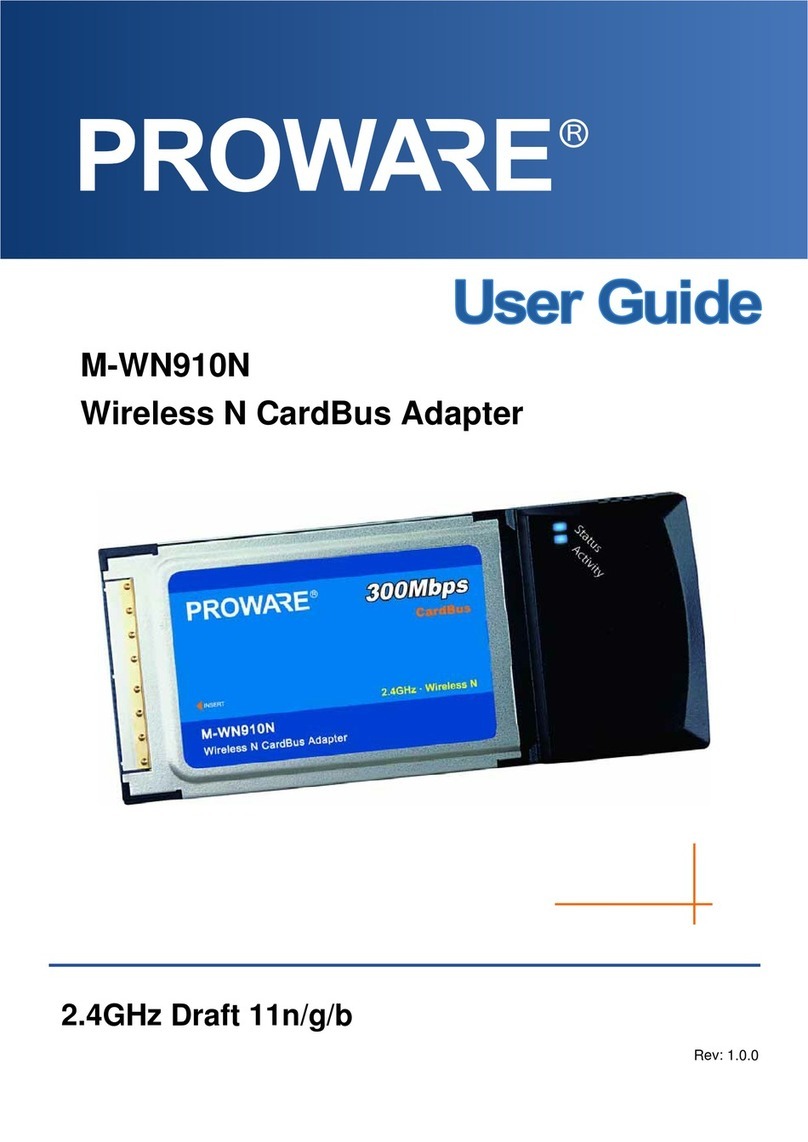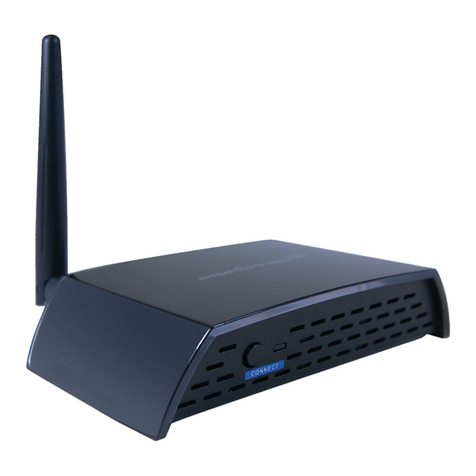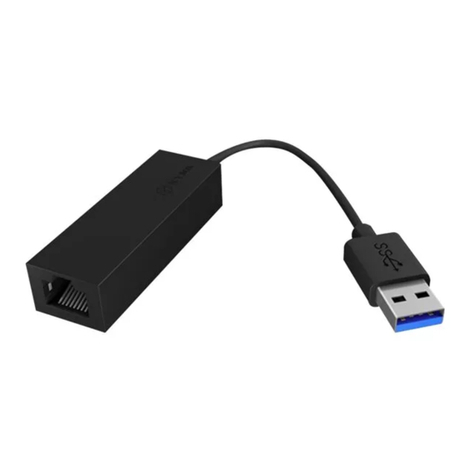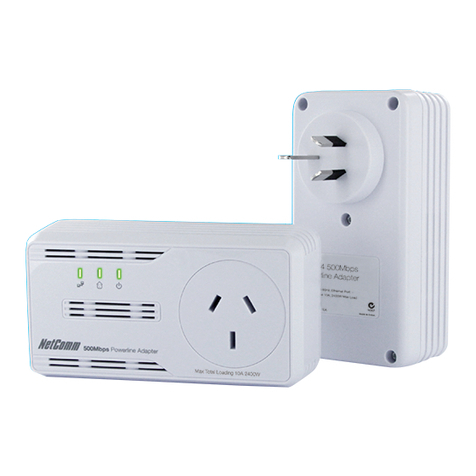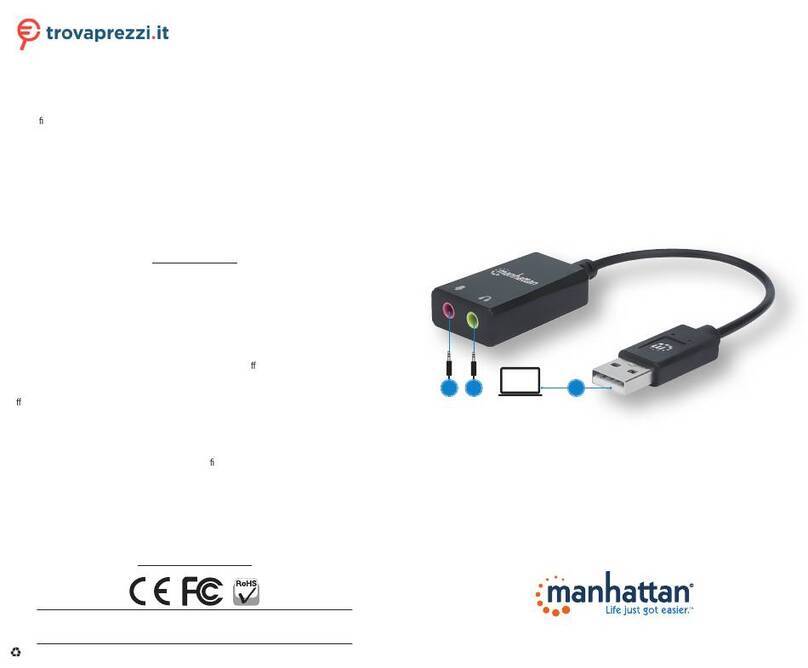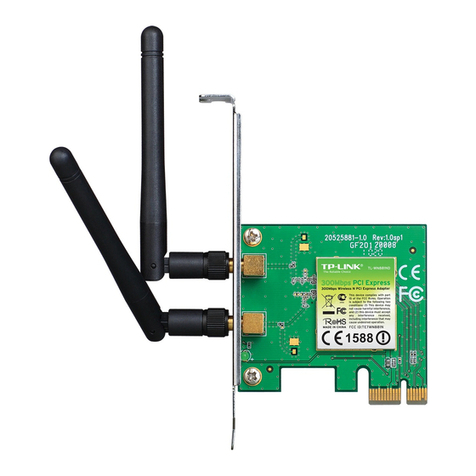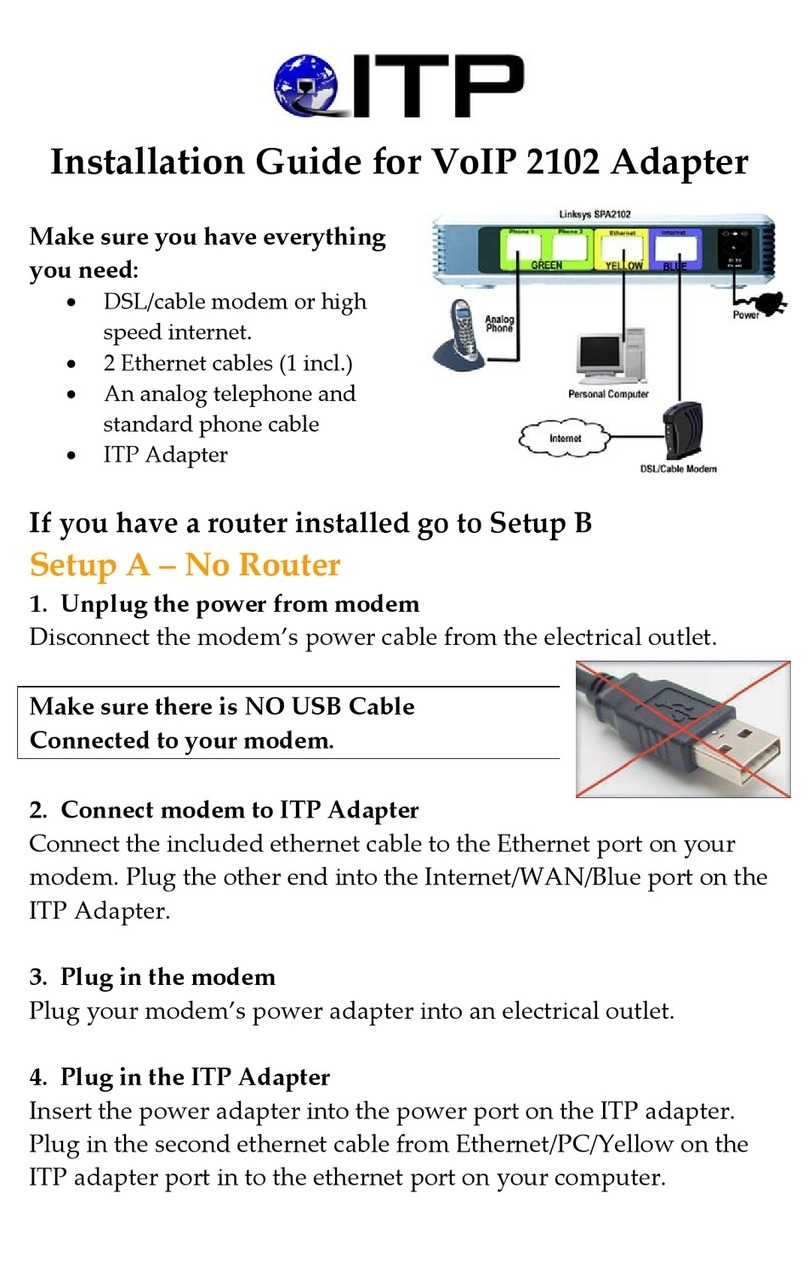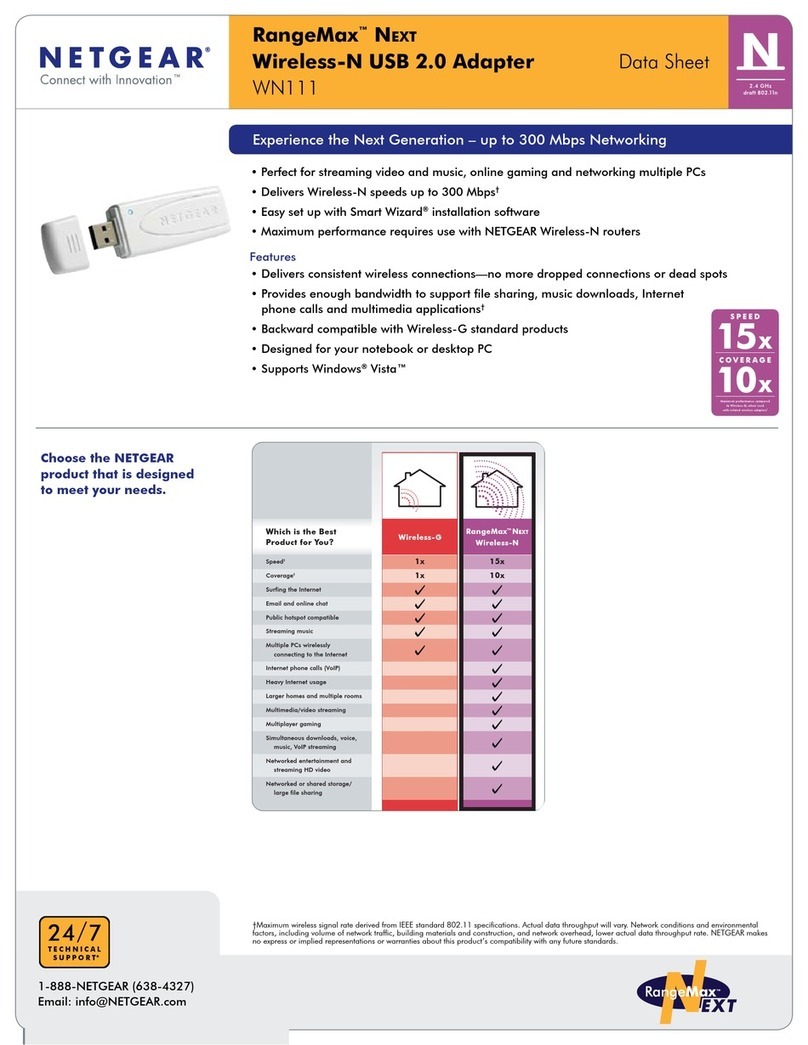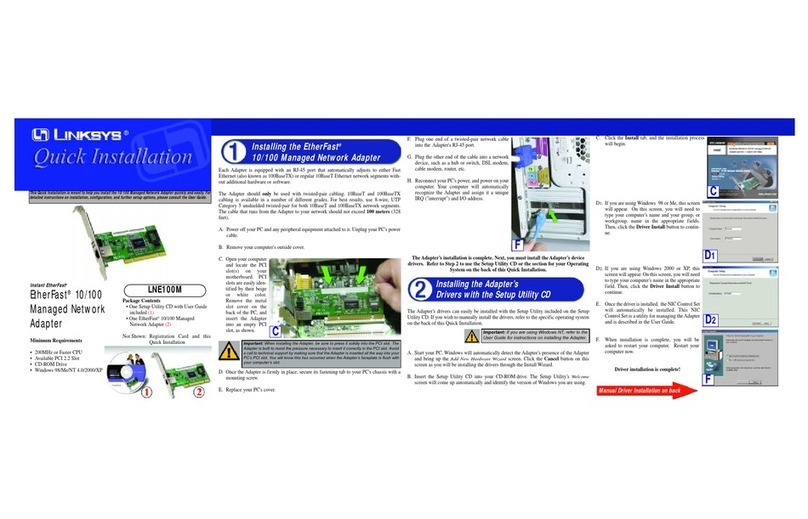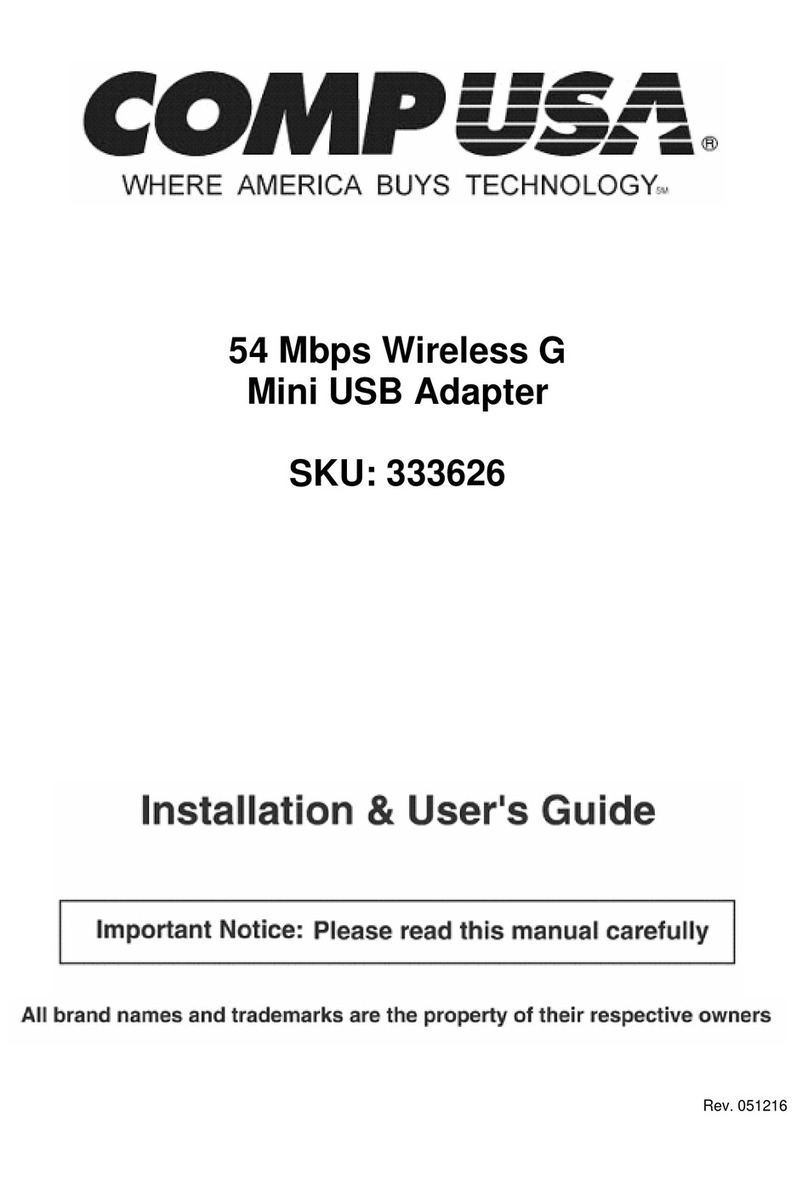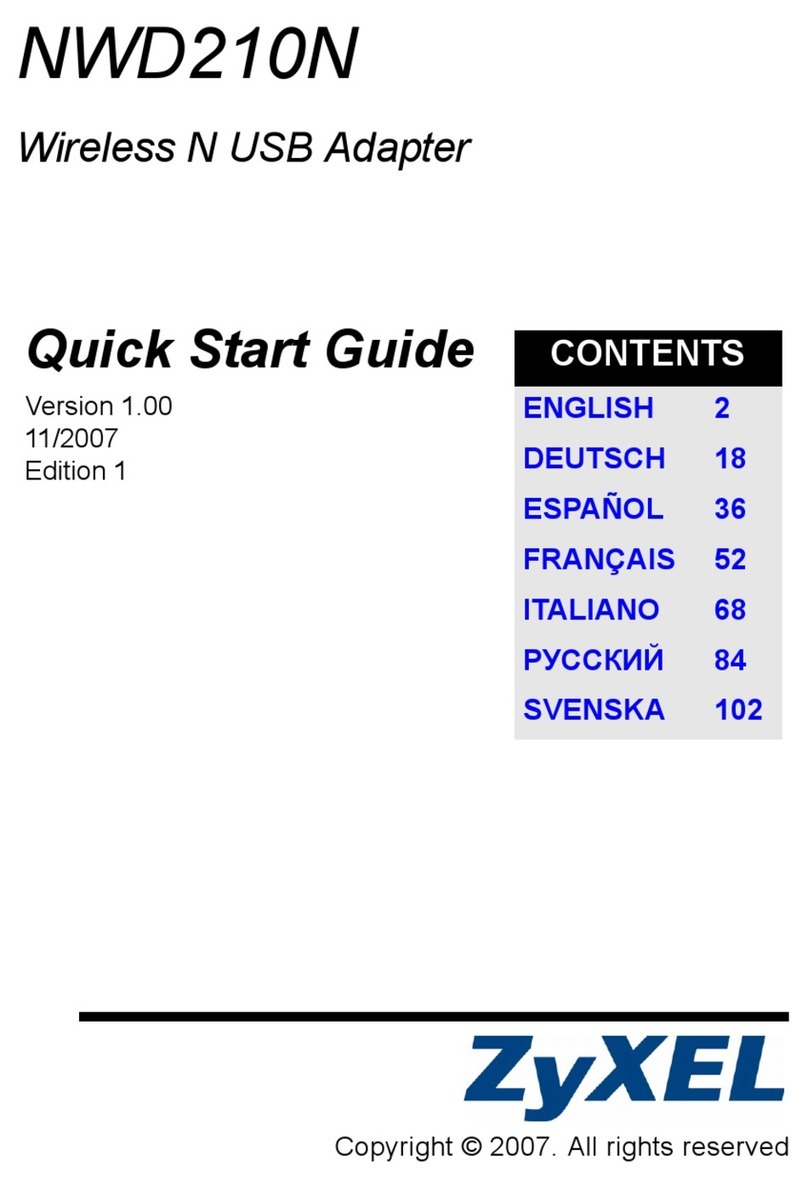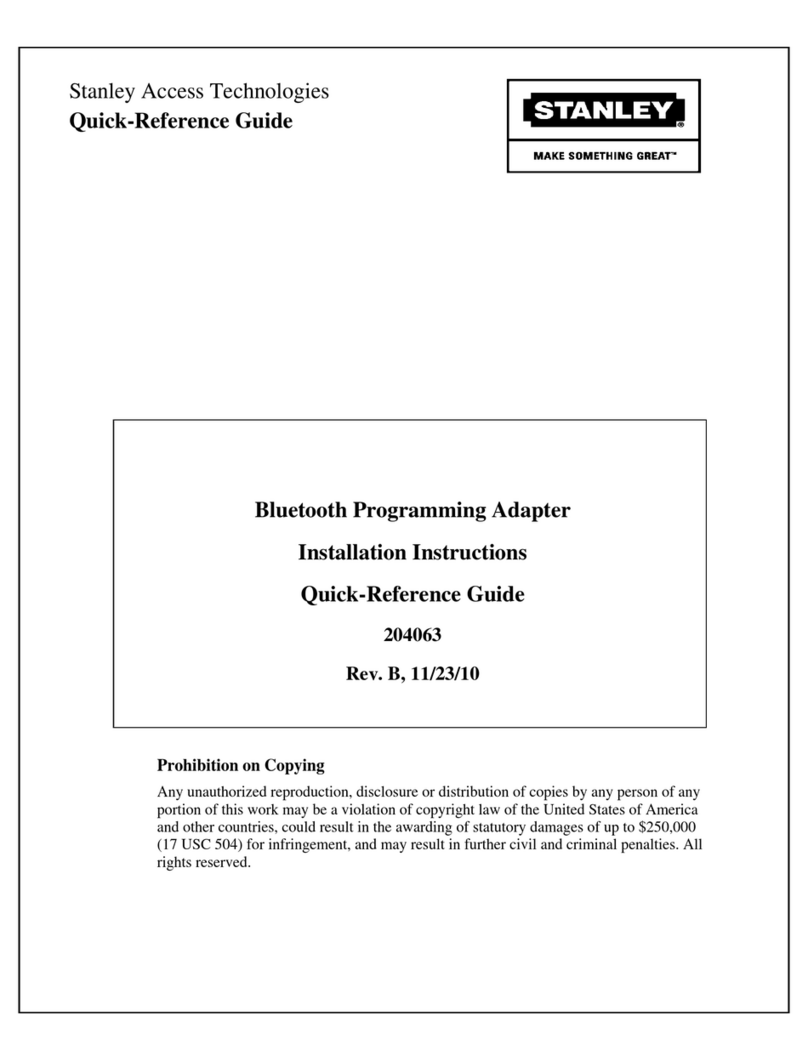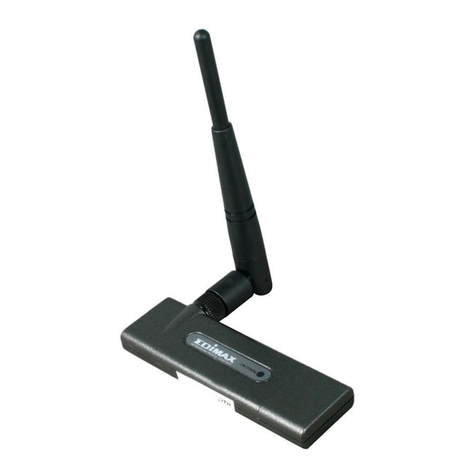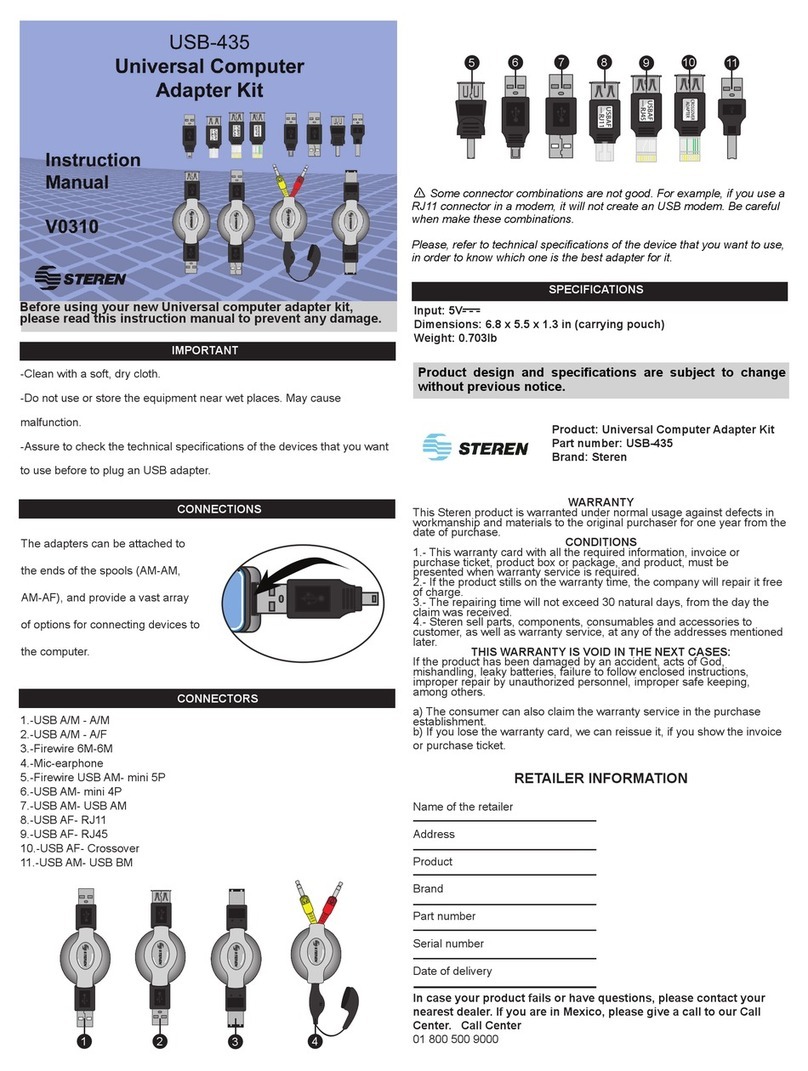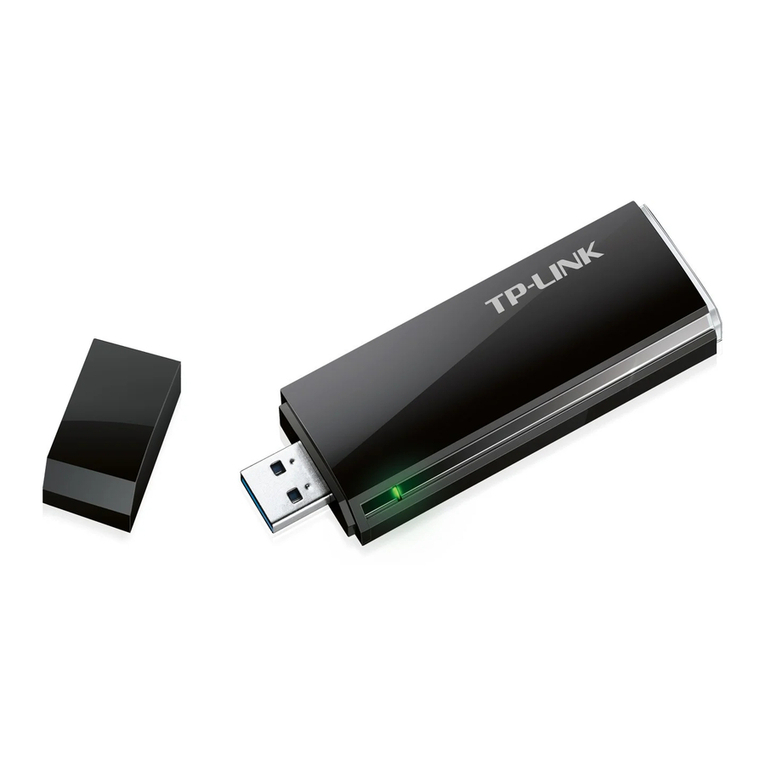Proware PW-MN561 User manual

PW-MN561
300Mbps Wireless N Mini PCI Adapter

COPYRIGHT & TRADEMARKS
Specifications are subject to change without notice. is a registered trademark
of PROWARE TECHNOLOGIES CO., LTD. Other brands and product names are trademarks
or registered trademarks of their respective holders.
No part of the specifications may be reproduced in any form or by any means or used to make
any derivative such as translation, transformation, or adaptation without permission from
PROWARE TECHNOLOGIES CO., LTD. Copyright © 2010 PROWARE TECHNOLOGIES CO.,
LTD. All rights reserved.
http://www.proware.com.cn

FCC STATEMENT
This equipment has been tested and found to comply with the limits for a Class B digital device,
pursuant to part 15 of the FCC Rules. These limits are designed to provide reasonable
protection against harmful interference in a residential installation. This equipment generates,
uses and can radiate radio frequency energy and, if not installed and used in accordance with
the instructions, may cause harmful interference to radio communications. However, there is no
guarantee that interference will not occur in a particular installation. If this equipment does
cause harmful interference to radio or television reception, which can be determined by turning
the equipment off and on, the user is encouraged to try to correct the interference by one or
more of the following measures:
•Reorient or relocate the receiving antenna.
•Increase the separation between the equipment and receiver.
•Connect the equipment into an outlet on a circuit different from that to which the
receiver is connected.
•Consult the dealer or an experienced radio/ TV technician for help.
This device complies with part 15 of the FCC Rules. Operation is subject to the following two
conditions:
1) This device may not cause harmful interference.
2) This device must accept any interference received, including interference that may cause
undesired operation.
Any changes or modifications not expressly approved by the party responsible for compliance
could void the user’s authority to operate the equipment.
The final end host device which contains this module must be labeled in a visible area with
"Contains FCC ID: WWMMN561V2”.
FCC RF Radiation Exposure Statement
This equipment complies with FCC RF radiation exposure limits set forth for an uncontrolled
environment. This device and its antenna must not be co-located or operating in conjunction
with any other antenna or transmitter.
“To comply with FCC RF exposure compliance requirements, this grant is applicable to only
Mobile Configurations. The antennas used for this transmitter must be installed to provide a
separation distance of at least 20 cm from all persons and must not be co-located or operating
in conjunction with any other antenna or transmitter.”

CE Mark Warning
This is a class B product. In a domestic environment, this product may cause radio interference,
in which case the user may be required to take adequate measures.
National Restrictions
2400.0-2483.5 MHz
Country Restriction Reason/remark
Bulgaria General authorization required for outdoor use and
public service
France
Outdoor use limited to 10 mW
e.i.r.p. within the band
2454-2483.5 MHz
Military Radiolocation use. Refarming of the 2.4 GHz
band has been ongoing in recent years to allow current
relaxed regulation. Full implementation planned 2012
Italy If used outside of own premises, general authorization
is required
Luxembourg None General authorization required for network and service
supply(not for spectrum)
Norway Implemented
This subsection does not apply for the geographical
area within a radius of 20 km from the centre of
Ny-Ålesund
Russian Federation Only for indoor applications
Note: Please don’t use the product outdoors in France.

CONTENTS
Package Contents....................................................................................................1
Chapter 1 Introduction...........................................................................................2
1.1 Overview of the Product.......................................................................................... 2
1.2 Features.................................................................................................................. 2
Chapter 2 Installation Guide..................................................................................3
2.1 Hardware Installation .............................................................................................. 3
2.2 Software Installation................................................................................................ 3
Appendix A: Specifications.....................................................................................4
Appendix B: Glossary..............................................................................................5

1
Package Contents
The following items should be found in your package:
¾PW-MN561 300Mbps Wireless N Mini PCI Adapters
)Note:
Make sure that the package contains the above items. If any of the listed items are damaged or
missing, please contact with your distributor.
Conventions:
The ‘Adapter’ mentioned in this user guide stands for PW-MN561 300Mbps Wireless N Mini
PCI Adapter without any explanations.

PW-MN561 300Mbps Wireless N Mini PCI Adapter
2
Chapter 1 Introduction
Thank you for choosing the PW-MN561 300Mbps Wireless N Mini PCI Adapter!
1.1 Overview of the Product
The adapter is an 802.11n client device; it is mainly designed to provide a high-speed and
unrivaled wireless performance for wireless embedded system application, such as EPON. Of
course, it also can be used into your notebook because of its standard Mini-PCI interface. With
a faster wireless connection, you can get a better Internet experience, such as downloading,
gaming, video streaming and so on.
With the 802.11n technology, higher throughput improvements using MIMO (multiple input,
multiple output antennas), the PW-MN561’s auto-sensing capability allows high packet transfer
rate of up to 300Mbps for maximum throughput. It has good capability on anti-jamming, and it can
also interoperate with other wireless (802.11b) products. The adapter supports WEP, WPA and
WPA2 encryption to prevent outside intrusion and protect your personal information from being
exposed.
With unmatched wireless performance, reception, and security protection, it is easily to be used in
different kinds of wireless embedded system for its mini size and portable.
1.2 Features
¾Complies with IEEE802.11n, IEEE802.11g, IEEE802.11b standards
¾Supports WPA/WPA2 data security, IEEE802.1x authentication, TKIP/AES encryption,
64/128/152-bit WEP encryption
¾Supports high rate of up to 300Mbps for maximum throughput, supports automatically
adjust to lower speeds due to distance or other operating limitations
¾Provides 32-bit mini-PCI interface
¾Supports Ad-Hoc and Infrastructure modes
¾Good capability on anti-jamming
¾Supports roaming between access points when configured in Infrastructure mode
¾Ease to configure and provides monitoring information
¾Supports Windows 2000, XP, Vista, 7
¾Built-in two internal antennas which are listed in a format of 2x2 for two receivers and two
transmitters.

PW-MN561 300Mbps Wireless N Mini PCI Adapter
3
Chapter 2 Installation Guide
2.1 Hardware Installation
PW-MN561 has standard 32-bit Mini-PCI interface, and it is mainly designed to provide stability
wireless function and performance for your system.
For installation, you must make sure that your device or system has the same slot for inserting
this adapter. And then, it is necessary to clean the device’s slot and adapter’s gold finger to
ensure both electrical properties fine. Finally, insert the adapter and finish the installation.
2.2 Software Installation
For it is mainly used in some embedded device, we don’t provide separate driver or utility. If this
adapter is used as its design, the device provider already integrates its driver to the whole
system software.
In the other hand, some users will get and use it in their own device, such as notebook. In this
condition, you can operate as the prompt of OS show to install driver.
)Note:
In the second situation, the driver will be installed online.

PW-MN561 300Mbps Wireless N Mini PCI Adapter
4
Appendix A: Specifications
Normal
Interface 32 bit Mini PCI Interface
Standards IEEE802.11n; IEEE802.11g; IEEE802.11b;
Operating System Windows 2000, XP, Vista
Throughput 300Mbps (Maximal)
Radio Data Rate
27/54/81/108/162/216/243/270Mbps
13.5/27/40.5/54/81/108/121.5/135Mbps
13/26/39/52/78/104/117/130Mbps
6.5/13/19.5/26/39/52/58.5/65Mbps
1/2/5.5/11Mbps
(Auto Rate Sensing)
Modulation
11b:CCK,QPSK,BPSK;
11g:OFDM;
11n: QPSK,BPSK,16-QAM,64-QAM
Media Access Protocol CSMA/CA with ACK
Data Security WPA/WPA2; 64/128/152-bit WEP; TKIP/AES
Frequency 2.4 ~ 2.4835GHz
Spread Spectrum Direct Sequence Spread Spectrum (DSSS)
Safety & Emissions FCC, CE
Environmental and Physical
Operating Temp. 0℃~40℃(32 ~104℉℉)
Storage Temp. -40℃~ 70 (℃-40℉~158℉)
Humidity 10% ~ 95% RH, Non-condensing

PW-MN561 300Mbps Wireless N Mini PCI Adapter
5
Appendix B: Glossary
¾802.11b - The 802.11b standard specifies a wireless product networking at 11 Mbps using
direct-sequence spread-spectrum (DSSS) technology and operating in the unlicensed radio
spectrum at 2.4GHz, and WEP encryption for security. 802.11b networks are also referred to
as Wi-Fi networks.
¾802.11g -specification for wireless networking at 54 Mbps using direct-sequence
spread-spectrum (DSSS) technology, using OFDM modulation and operating in the
unlicensed radio spectrum at 2.4GHz, and backward compatibility with IEEE 802.11b devices,
and WEP encryption for security.
¾802.11n - 802.11n builds upon previous 802.11 standards by adding MIMO (multiple-input
multiple-output). MIMO uses multiple transmitter and receiver antennas to allow for increased
data throughput via spatial multiplexing and increased range by exploiting the spatial diversity,
perhaps through coding schemes like Alamouti coding. The Enhanced Wireless Consortium
(EWC)[3] was formed to help accelerate the IEEE 802.11n development process and promote
a technology specification for interoperability of next-generation wireless local area
networking (WLAN) products.
¾Ad-hoc Network - An ad-hoc network is a group of computers, each with a Wireless Adapter,
connected as an independent 802.11 wireless LAN. Ad-hoc wireless computers operate on a
peer-to-peer basis, communicating directly with each other without the use of an access point.
Ad-hoc mode is also referred to as an Independent Basic Service Set (IBSS) or as
peer-to-peer mode, and is useful at a departmental scale or SOHO operation.
¾DSSS - (Direct-Sequence Spread Spectrum) -DSSS generates a redundant bit pattern for all
data transmitted. This bit pattern is called a chip (or chipping code). Even if one or more bits
in the chip are damaged during transmission, statistical techniques embedded in the receiver
can recover the original data without the need of retransmission. To an unintended receiver,
DSSS appears as low power wideband noise and is rejected (ignored) by most narrowband
receivers. However, to an intended receiver (i.e. another wireless LAN endpoint), the DSSS
signal is recognized as the only valid signal, and interference is inherently rejected (ignored).
¾FHSS - (Frequency Hopping Spread Spectrum) -FHSS continuously changes (hops) the
carrier frequency of a conventional carrier several times per second according to a
pseudo-random set of channels. Because a fixed frequency is not used, and only the
transmitter and receiver know the hop patterns, interception of FHSS is extremely difficult.
¾Infrastructure Network - An infrastructure network is a group of computers or other devices,
each with a Wireless Adapter, connected as an 802.11 wireless LAN. In infrastructure mode,
the wireless devices communicate with each other and to a wired network by first going
through an access point. An infrastructure wireless network connected to a wired network is
referred to as a Basic Service Set (BSS). A set of two or more BSS in a single network is
referred to as an Extended Service Set (ESS). Infrastructure mode is useful at a corporation
scale, or when it is necessary to connect the wired and wireless networks.
¾Spread Spectrum - Spread Spectrum technology is a wideband radio frequency technique

PW-MN561 300Mbps Wireless N Mini PCI Adapter
6
developed by the military for use in reliable, secure, mission-critical communications systems.
It is designed to trade off bandwidth efficiency for reliability, integrity, and security. In other
words, more bandwidth is consumed than in the case of narrowband transmission, but the
trade off produces a signal that is, in effect, louder and thus easier to detect, provided that the
receiver knows the parameters of the spread-spectrum signal being broadcast. If a receiver is
not tuned to the right frequency, a spread-spectrum signal looks like background noise.
There are two main alternatives, Direct Sequence Spread Spectrum (DSSS) and Frequency
Hopping Spread Spectrum (FHSS).
¾WEP - (Wired Equivalent Privacy) -A data privacy mechanism based on a 64-bit or 128-bit or
152-bit shared key algorithm, as described in the IEEE 802.11 standard. To gain access to a
WEP network, you must know the key. The key is a string of characters that you create.
When using WEP, you must determine the level of encryption. The type of encryption
determines the key length. 128-bit encryption requires a longer key than 64-bit encryption.
Keys are defined by entering in a string in HEX (hexadecimal - using characters 0-9, A-F) or
ASCII (American Standard Code for Information Interchange – alphanumeric characters)
format. ASCII format is provided so you can enter a string that is easier to remember. The
ASCII string is converted to HEX for use over the network. Four keys can be defined so that
you can change keys easily.
¾Wi-Fi - A trade name for the 802.11b wireless networking standard, given by the Wireless
Ethernet Compatibility Alliance (WECA, see http://www.wi-fi.net), an industry standards
group promoting interoperability among 802.11b devices.
¾WLAN - (Wireless Local Area Network) - A group of computers and associated devices
communicate with each other wirelessly, which network serving users are limited in a local
area.
¾WPA - (Wi-Fi Protected Access) -A wireless security protocol uses TKIP (Temporal Key
Integrity Protocol) encryption, which can be used in conjunction with a RADIUS server.
Table of contents
Other Proware Adapter manuals
